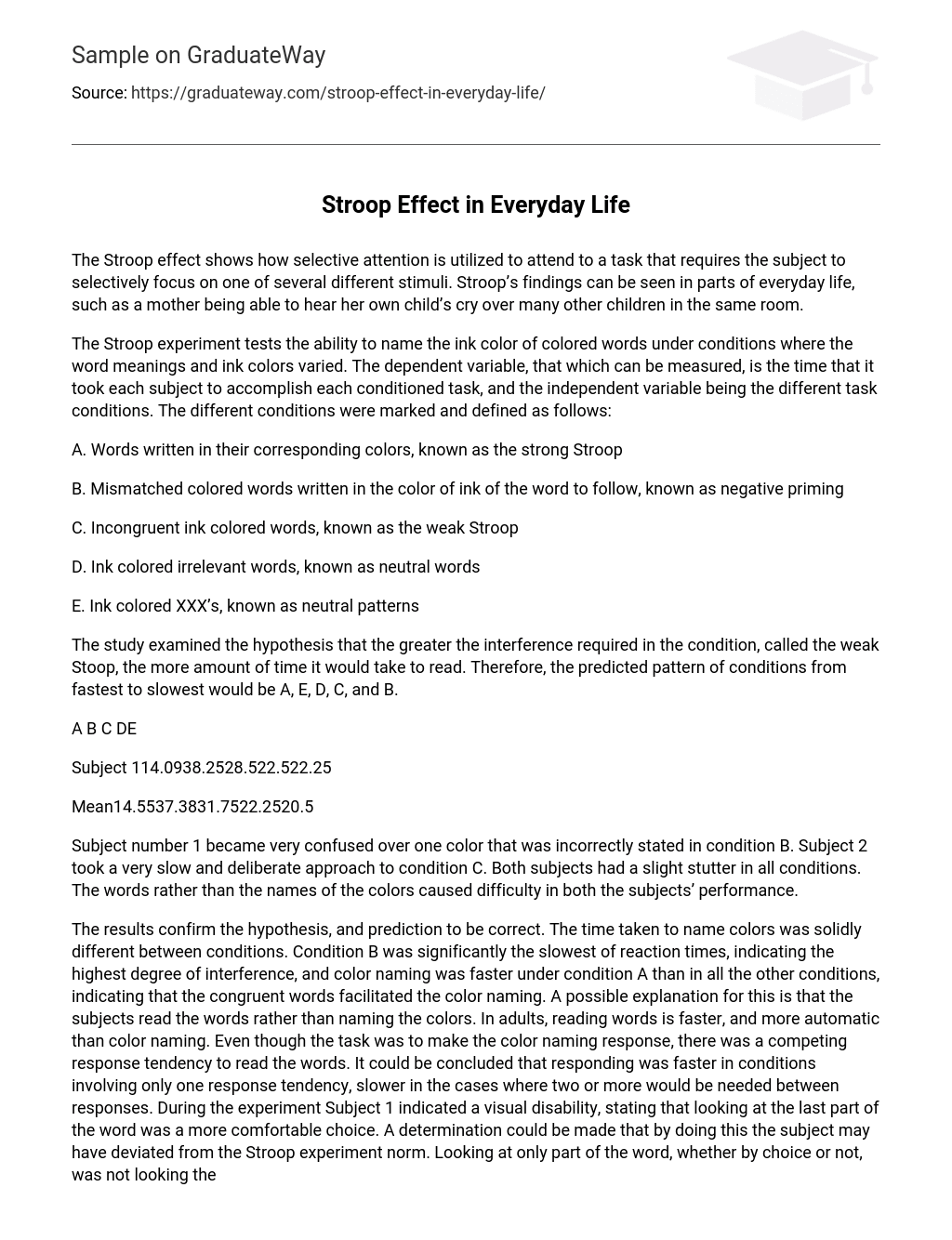The Stroop effect shows how selective attention is utilized to attend to a task that requires the subject to selectively focus on one of several different stimuli. Stroop’s findings can be seen in parts of everyday life, such as a mother being able to hear her own child’s cry over many other children in the same room.
The Stroop experiment tests the ability to name the ink color of colored words under conditions where the word meanings and ink colors varied. The dependent variable, that which can be measured, is the time that it took each subject to accomplish each conditioned task, and the independent variable being the different task conditions. The different conditions were marked and defined as follows:
A. Words written in their corresponding colors, known as the strong Stroop
B. Mismatched colored words written in the color of ink of the word to follow, known as negative priming
C. Incongruent ink colored words, known as the weak Stroop
D. Ink colored irrelevant words, known as neutral words
E. Ink colored XXX’s, known as neutral patterns
The study examined the hypothesis that the greater the interference required in the condition, called the weak Stoop, the more amount of time it would take to read. Therefore, the predicted pattern of conditions from fastest to slowest would be A, E, D, C, and B.
A B C DE
Subject 114.0938.2528.522.522.25
Mean14.5537.3831.7522.2520.5
Subject number 1 became very confused over one color that was incorrectly stated in condition B. Subject 2 took a very slow and deliberate approach to condition C. Both subjects had a slight stutter in all conditions. The words rather than the names of the colors caused difficulty in both the subjects’ performance.
The results confirm the hypothesis, and prediction to be correct. The time taken to name colors was solidly different between conditions. Condition B was significantly the slowest of reaction times, indicating the highest degree of interference, and color naming was faster under condition A than in all the other conditions, indicating that the congruent words facilitated the color naming. A possible explanation for this is that the subjects read the words rather than naming the colors. In adults, reading words is faster, and more automatic than color naming. Even though the task was to make the color naming response, there was a competing response tendency to read the words. It could be concluded that responding was faster in conditions involving only one response tendency, slower in the cases where two or more would be needed between responses. During the experiment Subject 1 indicated a visual disability, stating that looking at the last part of the word was a more comfortable choice. A determination could be made that by doing this the subject may have deviated from the Stroop experiment norm. Looking at only part of the word, whether by choice or not, was not looking the whole word. In contrast, if subject 1 had always seen the words in this manner, than that was the norm for subject 1, and thereby an accurate result. Perhaps the real damage here would be for subject 2, who has normal vision, to try the technique for faster times. Nevertheless, the results came out as predicted.
There are circumstances encountered everyday that require the need to switch attention back and forth between two or more stimuli. The need to focus or divide attention is largely determined by the demands of the user’s tasks. Such as, driving a car while talking on a cell phone. There are trade-offs in attention requirements, some automatic in nature, others need deliberate focus to accomplish. An argument could be made for an additional experiment by changing the font size, or by using color overlays that would slightly fade the ink color in varying degrees to see if the Stroop theory could still be validated.





